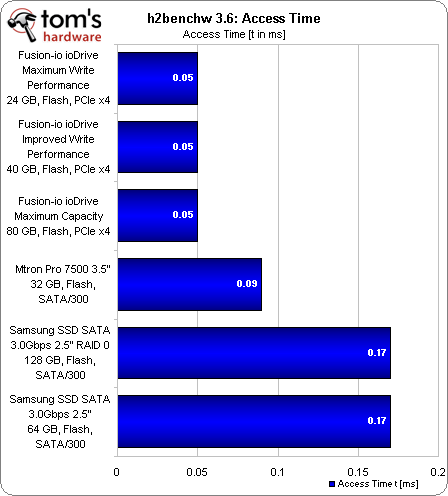Can The Flash-Based ioDrive Redefine Storage Performance?
Test Setup, Access Time
We compared the Fusion-io drive with another popular SLC-based flash SSD, Samsung’s 64 GB flash SSD, both in a standalone arrangement and configured in RAID 0 to increase performance. Intel’s X25-M and other flash SSDs weren’t included, as they are not based on the faster SLC flash memory, and they aren’t aimed at business or enterprise customers. You can check out the benchmark results in the following articles if interested:
Intel’s First Flash SSD Ready for Vertical Takeoff
Will SSDs Take Over the Enterprise?
| System Hardware | |
|---|---|
| Processors | Intel Core 2 Duo E8500 (45nm, 3.16 GHz, 6 MB L2 Cache) |
| Platform | Gigabyte P45T-Extreme, Rev 1.0, Intel P45 Chipset, BIOS 1710 |
| RAM | 4 x 1 GB DDR-1066 Crucial BL12864BA1608 |
| System Hard Drive | Seagate Barracuda 7200.980 GB, 7,200 RPM, 8 MB Cache, SATA/300 |
| Mass Storage Controller(s) | 82801JIR ICH10 RAID (ICH10R) |
| Graphics Card | ATI Radeon HD 3850 |
| Benchmarks | |
|---|---|
| Performance Measurements | h2benchw 3.6 |
| I/O Performance | IOMeter 2003.05.10, Fileserver-Benchmark, Webserver-Benchmark, Database-Benchmark, Workstation-Benchmark |
| System Software and Drivers | |
|---|---|
| OS | Microsoft Windows Server Standard x64 SP1 |
| Platform Driver | Intel Chipset Installation Utility 9.0.0.1008 |
| Graphics Driver | Radeon 8.11 |
| Fusion-io Driver | Release 1.2.2.14 |
Access time is probably the least interesting benchmark result, but the Fusion-io beats the Samsung and Mtron Flash SSDs by a significant margin here.
Get Tom's Hardware's best news and in-depth reviews, straight to your inbox.
Current page: Test Setup, Access Time
Prev Page Thoughts, Reliability, First Results Next Page Throughput, Interface Bandwidth